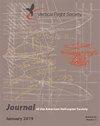未来旋翼机的飞行控制技术进步与挑战第40届亚历山大·a·尼古拉基荣誉讲座
IF 1.4
4区 工程技术
Q2 ENGINEERING, AEROSPACE
引用次数: 0
摘要
我第40次Alexander A. Nikolsky荣誉讲座和期刊论文的目标是突出过去50年来关键的飞行控制技术进步,并展示这些进步如何被应用和扩展到旋翼机的新家族:现代高速军用旋翼机,eVTOL城市空中机动性和先进的空中机动性飞机。这篇期刊论文的第一部分回顾了旋翼飞机独有的飞行控制技术驱动因素,并强调了过去50年来在操纵质量要求(ADS-33)、基于物理的模型、系统识别和飞行控制领域的关键进展。一个中心主题是从时域到基于频域的闭环响应特性的转变,旋翼飞机的设计方法越来越依赖于复杂的反馈控制系统,以实现闭环稳定性,抗干扰性,最重要的是全天候操作的闭环处理质量响应。频域分析,设计和测试方法的过去50年强调了相关的关键进展在每个学科和两个集成的例子成功的故事。在本文的第二部分,我们考虑了四种新型旋翼机的关键挑战、进展和未来需要研究的方向:军用未来垂直升力系列高速旋翼机、基于常规直升机的无人自主系统/城市空中机动、小型电动垂直起降无人飞行器旋翼机和大型垂直起降城市空中机动旋翼机。下一节横跨的挑战和解决方案的空间,这是共同的四个新的类旋翼飞机为所需的研究进展的蓝图。最后,本文从作者作为飞行控制工程师/研究员、飞行控制技术小组组长和高级技术专家的角度,回顾了本文的经验教训和关键收获。本文章由计算机程序翻译,如有差异,请以英文原文为准。
Flight Control Technology Advancements and Challenges for Future Rotorcraft 40th Alexander A. Nikolsky Honorary Lecture
The goal of my 40th Alexander A. Nikolsky Honorary Lecture and journal paper is to highlight the key flight control technology advances of the past 50 years and demonstrate how these advances are being applied and extended to the new family of rotorcraft: modern high-speed military rotorcraft, eVTOL urban air mobility, and advanced air mobility aircraft. The first part of this journal paper reviews flight control technologies drivers that are unique to rotorcraft and highlights key advances of the past 50 years in the areas of handling-qualities requirements (ADS-33), physics-based models, system identification, and flight control. A central theme is the shift from time-domain to frequency-domain based characterization of the closed-loop response and design methods for rotorcraft that have become increasingly dependent on sophisticated feedback control systems to achieve closed-loop stability, disturbance rejection, and most importantly closed-loop handling-qualities response for all-weather operations. Frequency-domain analysis, design, and test methods of the past 50 years are highlighted relating key advances in each discipline and two integrated example success stories. In the second part of this paper, we consider the key challenges, advancements, and needed future research for four new classes of rotorcraft: the military future vertical lift family of high-speed rotorcraft, unmanned autonomous systems/urban air mobility based on fielded conventional helicopters, small electric VTOL unmanned aerial vehicle rotorcraft, and larger eVTOL urban air mobility rotorcraft. The next sections look across the challenges and solution spaces that are common to these four new classes of rotorcraft as a blueprint for needed research advances. Finally, this paper takes a step back and considers the lessons-learned and key takeaways from the author's perspective as a career-long flight control engineer/researcher, Flight Control Technology Group leader, and senior technologist.
求助全文
通过发布文献求助,成功后即可免费获取论文全文。
去求助
来源期刊

Journal of the American Helicopter Society
工程技术-工程:宇航
CiteScore
4.10
自引率
33.30%
发文量
36
审稿时长
>12 weeks
期刊介绍:
The Journal of the American Helicopter Society is a peer-reviewed technical journal published quarterly (January, April, July and October) by AHS — The Vertical Flight Society. It is the world''s only scientific journal dedicated to vertical flight technology and is available in print and online.
The Journal publishes original technical papers dealing with theory and practice of vertical flight. The Journal seeks to foster the exchange of significant new ideas and information about helicopters and V/STOL aircraft. The scope of the Journal covers the full range of research, analysis, design, manufacturing, test, operations, and support. A constantly growing list of specialty areas is included within that scope. These range from the classical specialties like aerodynamic, dynamics and structures to more recent priorities such as acoustics, materials and signature reduction and to operational issues such as design criteria, safety and reliability. (Note: semi- and nontechnical articles of more general interest reporting current events or experiences should be sent to the VFS magazine
 求助内容:
求助内容: 应助结果提醒方式:
应助结果提醒方式:


